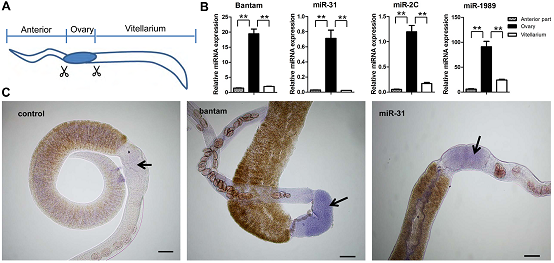Recently, innovative group of animal schistosomiasis led by Professor Guofeng Cheng at Shanghai Veterinary Research Institute of CAAS have found that miRNAs are involved in the regulation of ovary development in Schistosoma japonicum. This study was published in the PLoS Pathogens in February 2016.

Schistosomes are flatworms that are dioecious. Paired adult female schistosomes produce large numbers of eggs that are primarily responsible for the disease pathology and critical for dissemination. Consequently, understanding schistosome sexual maturation and egg production may open novel perspectives for intervening with these processes to prevent clinical symptoms and to interrupt the life-cycle of these blood flukes. In this study, researchers report on the identification of S. japonicum miRNAs using small RNA deep sequencing in the key stages of male-female pairing, gametogenesis, and egg production. Thirty potential target genes for 16 of the S. japonicum miRNAs were identified using antibody-based pull-down assays and bioinformatic analyses. Some of these targets were further validated by either in vitro luciferase assays or in vivo miRNA suppression experiments, and show that the female enriched schistosome miRNAs bantam and miR-31 play an important regulatory role in schistosome sexual maturation and ovary development. The research provided the first functional evidence for the role of miRNAs acting as important regulators in ovary development and sexual maturation. The development of a new strategy to target these miRNAs and thus reduce the egg production may help decrease parasite pathology and transmission in schistosomes.

More details are available on the bellow links:
http://www.plospathogens.org/article/related/info:doi/10.1371/journal.ppat.1005423

